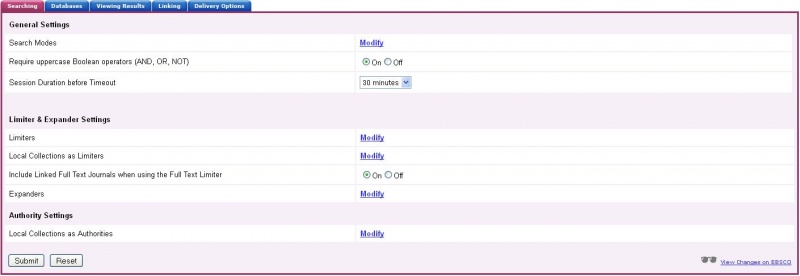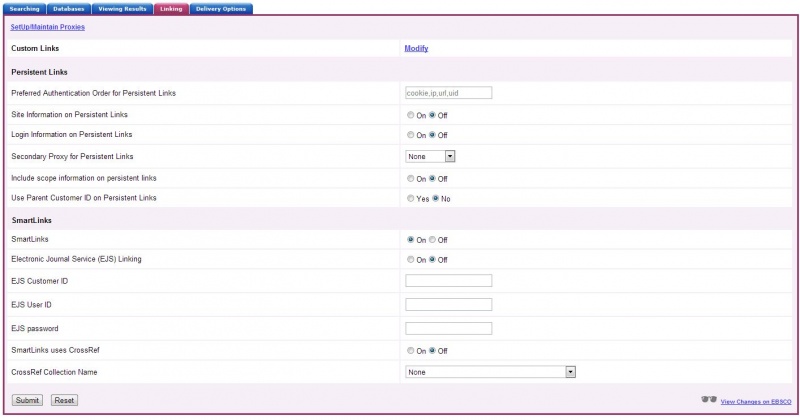Configuring Default API Settings in EBSCOadmin
Library administrator support allows librarians to use EBSCOadmin to configure default settings for the API. The settings are returned in the call to the /edsapi/rest/info endpoint and application developers can use those parameters rather than coding in values. Using the administrator settings allows more flexibility. The site behavior can be modified for users without requiring code changes from developers. The following settings are available in EBSCOadmin to customize how your API works.
Searching Tab

General Settings
- Search Modes
- Require uppercase Boolean operators (AND, OR, NOT) Defaulted Off
- Show Did-You-Mean Suggestion
- Auto Correct Search Terms
Limiter & Expander Settings
- Limiters: ID, label, type, order, Default to ON
- Expanders: ID, label, Default to ON
Viewing Results Tab

General Settings
- Number Of Results Per Page
- Result List View
- Select and Order Facets (Clusters) for display
- Display Image Quick View Results
- Display Research Starters Feature Area - Defaulted Off
Linking Tab

Setup/Maintain Proxies
Library administrators can set up or update the access information for a local proxy. For instructions on setting up a proxy using EBSCOadmin, visit the EBSCO Support Center:
How do I add a Proxy Server in EBSCOadmin and embed it in my EBSCOhost URL?
Custom Links
Custom links are an integral part of the EDS experience. They are used to enable efficient linking to data partners whose metadata we display, but whose full text resides outside of EDS. For information on setting up EDS custom links, please refer to the EDS partner database pages on EBSCO Connect.
Persistent Links
- Preferred Authentication Order for Persistent Links indicates the preferred order for authenticating a persistent link. The default order is Cookie, IP Address and Referring URL. You can enter as many of the choices listed as needed. They should always be entered in lower case and separated by commas.
- Login Information on Persistent Links includes login information on persistent link URLs when persistent links are created.
- Primary Proxy for Persistent Links can be used to enter the primary proxy for persistent links if applicable. This is the first proxy that is tried.
- Include scope information on persistent links set to Select On will automatically include scope=site on a persistent link. The patron will have full access from the article.
SmartLinks
- If you want to enable SmartLinks for the profile, select On. For the Student Research Center, this is applied to a Teacher Resources search only.
- If you subscribe to the Electronic Journals Service, in the Electronic Journals Service (EJS) Linking field, select On.
- Enter your EJS Customer ID, User ID and password.
- If SmartLinks uses CrossRef, then select On.
- From the drop-down list, select the CrossRef Collection Name.
Updated over 1 year ago
